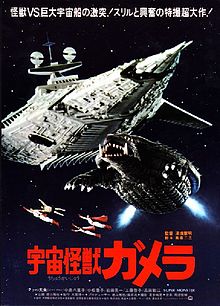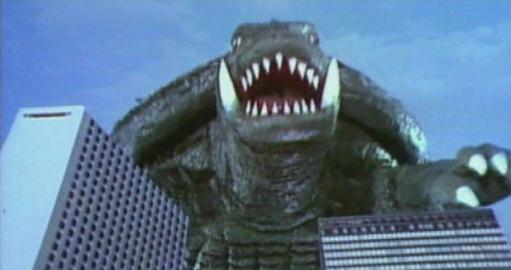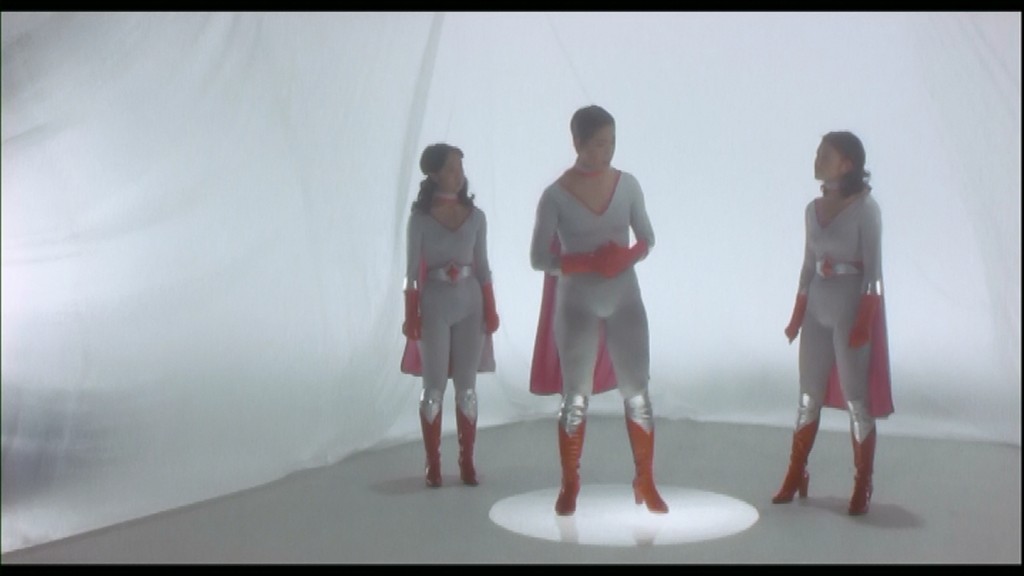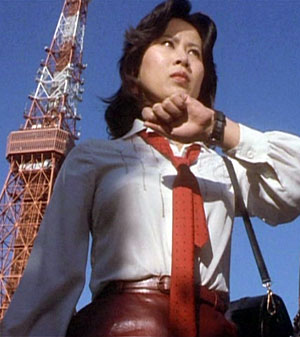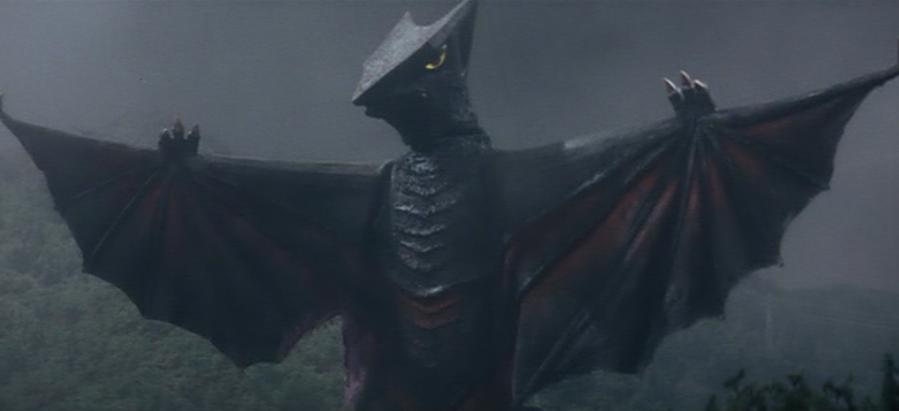Welcome to Angry Turtle!, a series featuring Deadshirt.net’s own Patrick Stinson and guest writer Andrew Tucker. We are going to be looking at the Gamera series, the films made by a rival studio to compete directly with the famous Godzilla series. The name comes from this charming video.
Patrick: Today we are looking at the first Gamera film to post-date Daiei’s bankruptcy, and the last Gamera film produced in the “Showa” imperial era. Gamera: Super Monster is…well. It is.
Andrew: Ironically, this movie also serves as a reboot that also relies almost solely on stock footage for the kaiju scenes. I believe I read that original footage of Gamera clocks in around two minutes, which involves a Gamera puppet that looks more like Universal Studios’ late Jaws ride than the original Gamera suit.
Patrick: Nowadays this is accepted as a Showa Gamera film for marketing purposes and such but it’s worth pointing out that as much time passed between this and Zigra as did between the Showa and Heisei Godzilla series. Original Gamera director Noriyuki Yuasa returns once again, and inasmuch as this bare-bones movie has a creative thrust, it’s a sort of remixing of all of the various concepts he had from Gamera the Giant Monster onward. There’s space women, evil space women, a boy who has to abandon a turtle and thinks it becomes Gamera (but he’s maybe right this time?), Gamera being mind-controlled, dismissive adults yet strangely helpful military…but then layered on top of THAT is a weird Sailor Moon/Super Sentai kind of plot.
Andrew: And then there’s the Star Destroyer. Yes, this movie opens with an image straight out of 1977’s Star Wars in which the evil alien force comes roaring through space in a triangular space cruiser with two dishes on either side of the command bridge. It even appears from the top of the screen a la Star Wars. This movie came out in 1980, the same year as The Empire Strikes Back, so it’s no wonder a series that relied on space fantasy would borrow from the cultural phenomenon that is Star Wars, but damn. The opening of this movie is straight-up plagiarism.
Patrick: It is BOLD, like those Turkish and Indian ripoffs that the Alamo Drafthouse likes to use in their pre-shows. But I turned up an interview with Yuasa that kind of explains a little of this attitude. He was very much about entertaining kids in the moment, not thinking about his movies as cultural artifacts. With this movie’s micro-budget, about the only way to go was lean in. Compared to other Japanese productions in 1980, the cheesiness is certainly deliberate and ironic. So…we could call it cynical irony. Anyway, it’s certainly successful on this sort of pure entertainment level, sort of like one of those Chuck Jones compilations that were released to home video in our generation. I enjoyed it more than Viras. But you just can’t get away from the fact that it’s a clip show movie, held together by sets made of bedsheets and old vans.
Andrew: The plot (and I use that word lightly) revolves around a group of alien sentinels guarding Earth whilst being hunted by an opposing alien force from space. To be honest, I’m not sure how much we can call them guardians, because they don’t really have a plan to protect the planet. The invaders, in an effort to flush out the trio of super sentais, unleash all of the previous baddies in the Gamera canon. Our protectors’ response? “Well, crap. Better go back to work at the pet store.” By the way, the people of Earth are never really that bothered by a slew of giant monsters wreaking havoc across the planet, are they?
Patrick: There is a sort of dream-logic at work, yes. While Gyaos —the first monster to appear and, not coincidentally, the one with the second-largest impact on the plot—is acknowledged as a threat in-universe, the few human adults in the film regard main character Kenichi as a sort of monster-obsessed crank. Using stock footage apparently amped up the usual disconnect of human and kaiju plots into areas well exceeding even Power Rangers. Cities are just being toasted left and right in the stock footage, but Kenichi needs to get off his monster kick? It’s one line of dialogue away from being an explicit dream-sequence kaiju movie such as Ishiro Honda’s All Monsters Attack.
Not helping are two rather lengthy scenes of Kenichi’s actual dreams, which do foreshadow the ending but exist mainly to marry the film’s new Gamera puppet to stock footage from anime. That’s right, this movie needs to resort to traditional animation to boost the level of effects spectacle. This is the weirdest thing in what you no doubt have gathered is a weird movie. I don’t even know what to call it, originally unoriginal?
Andrew: I wish the movie actually committed to more sequences like this. I understand that they lost their budget, but the filmmakers could have salvaged this movie going the route of “kid in the real world daydreams about Gamera to get through his actual problems.” Gamera is even established early on as a comic book character, so it would have been plausible. Instead, we’re left with a plot that relies on its drama solely from a trio of spandex-wearing women dodging a laser blast from space while the audience sits through seven years worth of Gamera cutscenes. The love Kenichi has for Gamera (formerly his pet turtle) is the saving grace of this movie. He loves Gamera more than any other child protagonist since the first film, and I thought Kenichi was far more emotionally invested.
Patrick: This is pure uncut speculation, but I wonder if the dream quality came from Yuasa’s budget being cut, or if he pitched it this way and the studio wanted it to be “real.” Other budget-related weirdness is the fact that in addition to the new puppet they DID construct a new suit for Gamera, but the only scene it is used in in the final film is a brief gag where Gamera knocks over a Godzilla sign.
Anyway, I’ve had worse times than plowing through the highlight reel of Gamera. The fights in the actual films tend to drag a bit, and rearranging them brings out little moments and highlights that I didn’t catch before. There’s even a hint of inspiration in setting the Zigra fight and the Viras fight on the same beach, and ending it with Gamera getting the mind control device from Viras and the space women having to finally use their actual powers for once and get it off of him. Unfortunately, what could have been edited together into a vaguely credible plot is actually presented as the Evil Space Woman desperately begging a Generic Alien Voice from the Star Destroyer to “give me another chance to live, send another monster, pretty please.”
Andrew: There’s been an interesting motif of having the alien women be ruled by non-human male characters. I’m not sure if this favors or hinders these female characters, but our Evil Space Woman here actually has a deeply emotional, and very Japanese, end to her story arc, and her sister alien guardians beg her to join them only to watch her commit the science-fantasy version of seppuku.
Patrick: You’re a charitable man, Andrew. “Interesting” is not quite how I’d describe that motif. And while the movie does manage genuine pathos in ESW/Giruge’s defeat and redemption, it squanders it with her needless sacrifice. It seems to pillage a bit from the end of Terror of Mechagodzilla, the most recent major kaiju release. But Katsura’s fate had meaning in the prior film, and Giruge’s is just another glorification of suicide. Combined with the OTHER major plot point of the ending, it’s way too dark and messes up “children’s adventure movie” tone that was the only thing it had going for it.
Andrew: I will grant you that the tone of the overall movie doesn’t match the tone of the suicide scene and that Giruge’s character isn’t as well-written as other characters who sacrifice their lives, but I think the general mashup of tones is more of a cultural thing than anything else. The kaiju films all ping-pong between fun, family action, and shots of people being reduced to skeletons and giant monster birds eating people. I think kaiju-eiga, or Japanese monster movies, play by culturally different rules.
Patrick: Anyway, the other great sacrifice play is the only original battle in the film, Gamera vs. The Star Destroyer that Somehow Hasn’t Been Defeated Already By Legal Action. (Aside: I know this is a cheap gag that makes it into every review of this movie and I swore I wasn’t going to use it but then I watched the film and LOOK AT THAT THING LOOK AT IT.) Just like in Kenichi’s dreams, Gamera blasts his way up there and we are treated to some awkward match cuts of a turtle puppet, a Lucasian model, and an explosion. Then we are informed by the Space Women on the ground that Gamera is no more, and has sacrificed himself to save everyone. Kenichi is pretty sad, but then they all fly around like Superman so that helps I guess. What are your thoughts, Andrew?
Andrew: I feel bad for Daiei and director Noriyuki Yuasa watching this movie. If this were a direct follow-up to Zigra, I could accept it as the first series petering out. Instead, this movie wants to be something of a reboot and a retrospective of the series, and is dragged down by all of the terrible new elements that remind us of all the things that didn’t work in Gamera’s first run—despite the character and many of his foes being memorable enough to stand next to Godzilla and his crew. I believe you described this film as a “mercy killing” for the Showa Gamera, and I think that’s the best way to describe it in the end.
Patrick: Now that I’ve seen it I’m actually going to walk that back a little, because it’s so clear that this is NOT a reappearance of the Gamera we just saw in seven other movies. It is a reboot, and as such does not depict the death of “the” Gamera. Ultimately this is the least essential Gamera film as a result. Unless you have a small child in a very specific age range, or a couch of buddies ready to give it a good riffing, it is of only historical interest. After this film, expectations for Gamera were at an all-time low, and he stood ready to disappear into obscurity as a Godzilla rip-off, and not even a good one. So get ready for director Shusuke Kaneko to change everything in 1995…
Andrew: Oh boy, oh boy, oh boy, oh boy…!

